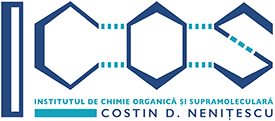Development of light-responsive poly(2-oxazoline)s micelles as a theranostic platform for improved tumor-targeted drug-delivery
- RESPOXA -
Project ID: PN-III-P1-1.1-TE-2019-1696
Project leader: Valentin Victor Jerca
Project type: National Funding
Project program: Research projects to stimulate the establishment of young independent research teams – TE competition 2019
Funding Agency: Unit Executive for Funding Higher Education, Research, Development and Innovation
Contractor: Institute of Organic and Supramolecular Chemistry “Costin D. Nenitescu”
Start date: 14 January 2021
End date: 31 December 2022
Project abstract:
The present project aims at developing a theranostic platform based on red light responsive poly(2-oxazoline)s (POx) as nanocarriers for improved drug delivery in cancer therapy. Cancer treatment with conventional cytostatics often suffers from low efficiency and occurrence of severe side effects. Therefore, innovative diagnostic and therapeutic strategies are imperative for detection and personalized treatment of cancer. Theranostic is defined as a material that combines the modalities of therapy and diagnostic imaging. POx has been studied extensively as highly potent platform to develop amphiphilic block copolymers due to several advantages, such as non-immunogenicity, no known antibodies in the human population, no organ accumulation and relatively low viscosity in aqueous solution. In addition, POx exhibit good biocompatibility, hydrophilicity, and enable orthogonal functionalization possibilities, thus, allowing multiple possibilities to construct micelles nanocarriers for drug-delivery purposes. The azobenzene containing polymers offer tremendous advantages and opportunities over stimuli-responsive materials to interface with biomedical application, especially red-light responsive polymers that have photo pharmacological potential. Via the herein proposed objectives and activities, the multidisciplinary team of young researchers aims to demonstrate that by combining the best of POx and azobenzenes potential, the red-light responsive POx nanocarriers may represent a feasible solution in the construction of advanced theranostic platform for target drug-delivery systems.
(O1) The first objective is to design the red-light-responsive POx block-copolymers with a balanced content of Azo-Oxa in order to achieve micellar behavior. This objective corresponds to a TRL 1 level aiming towards an Experimental Concept, based on the previous expertise on developing POx-based polymers.
(O2) The second objective aims to test and validate the stability and drug loading efficiency of the RLR-POX nanocarriers with mitoxantrone as the model drug. This objective corresponds to a TRL 2 aiming towards Experimental Models.
(O3) The third objective aims to have a proof-of-concept of the working principle of the RLR-POX as efficient on-demand drug-delivery nanocarriers and their interaction with tumor cells as well as live cell imaging. From experimental models towards Functional designs - this objective corresponds to a TRL 3.
(O4) The fourth objective takes into account the following aspects related to the project: (i) the administrative and scientific risks that meet mitigation solutions in a complete risk management plan; (ii) protection of the intellectual property via a national patent claim; and (iii) dissemination strategies of mid-term outcomes at international level consisting in scientific articles and communications to conferences/congresses.
Project leader:
Dr. Ing. Valentin Victor Jerca
Email: victor_jerca@yahoo.com, victor.jerca@ccocdn.ro
Postdoctoral member:
Dr. Ing. Florica Adriana Jerca
Email: adriana_jerca@yahoo.com, adriana.jerca@ccocdn.ro
Postdoctoral member:
Dr. Ing. Doriana Nicoleta Banu
Email: doriana.banu@yahoo.com, doriana.banu@ccocdn.ro
Postdoctoral member:
Dr. Ing. Diana Elena Giol
Email: diana_giol@yahoo.com
Phd. Student
Emilian Ghibu
Master Student
Ciprian Victor Florea
Stage 1/2021
Activity 1.1 Experimental syntheses of precursors have been performed.
Activity 1.2. Experimental synthesis of reference materials has been optimized.
Activity 1.3. The experimental development of micelles has been conducted.
Activity 1.4. The micellization procedure and micellar stability was investigated.
Activity 1.5. Dissemination through international communication and publication of preliminary results has been successfully accomplished.
Stage 2/2022
Activity 2.1 Validation of response time to photoirradiation of micelles was achieved.
Activity 2.2 Validation of loading protocols with drug of micellar systems was achieved.
Activity 2.3 The evaluation of the functionality of the micellar systems for in vitro drug release was performed.
Activity 2.4 Cytotoxicity evaluation of micellar systems was investigated.
Activity 2.5 Dissemination through international communication and publication of preliminary results has been successfully accomplished.
Summary
In the first stage of the project, a series of functional monomers was synthesized from 2-isopropenyl-2-oxazoline, among which azo derivatives were introduced for the subsequent preparation of POx copolymers sensitive to red light. All monomers were properly characterized from the physico-chemical point of view and tested in living ionic polymerization. The composition of the copolymers was optimized from the hydrophilic-hydrophobic balance for micellization purposes in aqueous medium, as well as the contrast agent content. The physico-chemical properties as well as the material properties of the resulting copolymers were investigated in detail. The response to the light stimulus of the copolymers developed in the first phase was optimized and validated.
In the second stage of the project, thorough studies were carried out on the micellization behavior of copolymers in aqueous medium and the loading efficiency, data reproducibility studies and scale-up synthesis. Stable micelles were obtained in simulated physiological fluids, which can release the encapsulated drug in the presence or absence of the light stimulus. In addition, the release of pharmacologically active compound on demand as well as reversibility was demonstrated within the investigated drug delivery systems. Following these studies, a systematic improvement in drug release performance was observed between light-stimulated versus unstimulated micelles (reference). Herein, the interaction of raw materials, intermediates, and copolymers with different cell lines was determined, which contributed to the differentiation of the level of cytotoxicity in all experimental stages.
Based on the preliminary results, three scientific papers were developed, among which one scientific paper is published in a specialized journal from Nature with high FI, the second one is under evaluation in a specialized journal, and the third paper will be sent for publication by the end of the year. To protect intellectual property rights, a national patent application was submitted to the OSIM headquarters, which includes the development of NEW FUNCTIONAL MONOMERS FROM 2-ISOPROPENYL-2-OXAZOLINE. The dissemination of the preliminary scientific results was also done by participating to 6 (inter)national conferences.
Publications
1. Jerca, F.A.; Jerca, V.V.; Hoogenboom, R.; “Advances and opportunities in the exciting world of azobenzenes”, Nature Reviews Chemistry, 2021, impact factor 34.035
https://doi.org/10.1038/s41570-021-00334-w
2. S. Saravanan, A. Babu, R. Merckx, Z. Zhong, B.G. De Geest, R. Hoogenboom, V.V. Jerca, S. Maji, “Design of fluorescent polymeric thermometers based on anthrapyrazolone functionalized oligo(ethylene glycol) methacrylates”, under review in Materials Chemistry Frontiers.
Patent claim
F.A. Jerca, V.V. Jerca, N.D. Banu, M.A. Molența, PROCEDEU DE OBȚINERE AL UNOR MONOMERI FUNCȚIONALI PE BAZĂ DE 2-IZOPROPENIL-2-OXAZOLINĂ FOLOSIȚI ÎN DEZVOLTAREA DE MATERIALE POLIMERICE INTELIGENTE, no. A2022/00774 with deposit date 28.11.2022.
Conferences
1. C. Florea, E. Ghibu, N.D. Banu, D.M. Vuluga, F.A. Jerca, V.V. Jerca, “Process optimization of poly(2-oxazoline)s stabilized polymeric carriers”, 15th International Conference on Materials Chemistry (MC15), online, 12-5 iulie 2021. Poster online
2. F.A. Jerca, V.V. Jerca, “Poly(2-isopropenyl-2-oxazoline)-A versatile platform for advanced multifunctional materials”, Progress in Organic and Macromolecular Compounds, 28th Edition, Iași, România, 7-9 octombrie 2021. Lecture
3. V.V. Jerca, F.A. Jerca, “Designing Degradable Poly(2-Isopropenyl-2-Oxazoline)-Materials for Drug Delivery Applications”, 14th International Symposium on Ionic Polymerization, Ionic Polymerizations to Develop Advanced Functional Materials, 11-16 Septembrie 2022, Ghent, Belgium. Oral communication
4. N.D. Banu, I. Banu, D.M. Vuluga, F.A. Jerca, V.V. Jerca, THERMAL DEGRADATION OF POLY(2-ISOPROPENYL-2-OXAZOLINE), a XXXVI-a CONFERINŢĂ NAŢIONALĂ DE CHIMIE, 4-8 octombrie 2022, CĂLIMĂNEŞTI-CĂCIULATA, Poster
5. M.A. Molența, F.A. Jerca, V.V. Jerca, “2-Izopropenil-2-Oxazolina Platformă Versatilă pentru Sinteza de Monomeri Funcționali” Simpozionul 120 de ani de la nasterea Academicianului Costin D. Nenitescu, 22-23 Septembrie 2022, Romanian Academy, Bucharest. Oral communication
6. N.D. Banu, I. Banu, D.M. Vuluga, F.A. Jerca, V.V. Jerca, MECHANISMS AND KINETICS OF THERMAL DEGRADATION OF POLY(2-ISOPROPENYL-2-OXAZOLINE), International Symposium on Polymer and Supramolecular Chemistry, 25 Octombrie 2022, Bucuresti, Oral communication





